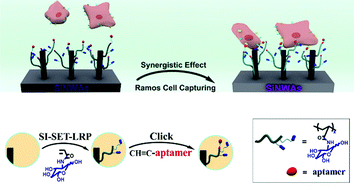Hong Chen*a(陈红)
a The Key Lab of Health Chemistry and Molecular Diagnosis of Suzhou, College of Chemistry, Chemical Engineering and Materials Science, Soochow University, 199 Ren'ai Road, Suzhou 215123, P. R. China.
b Center for Soft Condensed Matter Physics and Interdisciplinary Research, Soochow University, Suzhou 215123, P. R. China.
Polym. Chem. 2015, 6, 3708–3715
Circulating tumor cells (CTCs) exist in extraordinarily low numbers in the blood of patients with solid tumors, and thus the discovery of a more effective, economical and specific way to capture tumor cells is essential and still remains a tremendous challenge. In this work, the glycopolymer, poly(N-acryloyl glucosamine) (PAGA), and TD05 aptamers were combined on silicon nanowire arrays (SiNWAs) to capture Ramos cells through SET-LRP and click chemistry for the first time. The polymerizations showed controllable living features using 2-hydroxyethyl α-bromoisobutyrate (HEBiB) as a sacrificial initiator. In a serumcontaining environment, PAGA-modified surfaces could catch small amounts of Ramos cells. Furthermore, the number of captured specific Ramos cells increased extensively compared with the control after the introduction of the aptamer molecule TD05 onto the PAGA-modified surface. A few non-specific Baf3 cells were captured on the surfaces prepared. The results revealed the synergistic effect generated by combining a glycopolymer and aptamer, which could achieve multivalency-enhanced effective and specific cancer cell capturing, thus suggesting that this can be a promising approach for cancer detection.

链接:
//pubs.rsc.org/en/Content/ArticleLanding/2015/PY/c5py00247h